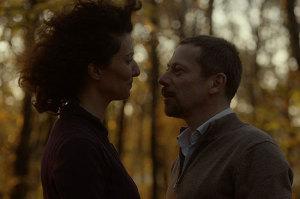
Stéphanie Cléau and Mathieu Amalric star in French thriller, “The Blue Room.”
★★★★☆
Few filmmakers have been able to accurately portray the brusque, darkly nuanced tones of love. This rendition of love, often deliberately underrepresented in film, is not found in an average Nicholas Sparks novel or a sappy Katherine Heigl rom-com. In his new film “The Blue Room,” director, writer and lead actor, Mathieu Amalric (Quantum of Solace, The Grand Budapest Hotel) paints a picture of the dual nature of love as he tells the story of a secret love affair paralleled with an unspecified police investigation.
As an actor-turned-auteur, Amalric grounds the mystique of the affair in a nefarious context. Through the fragmented memories of Julien, Amalric touches on the notion that love is confusingly manipulative. The ugly truth is that sometimes love is an all-purpose excuse for selfish behavior. We can lie, we can cheat, and it’s all ok because we’re in love.
“If I were suddenly free, could you free yourself too,” says Esther (Stéphanie Cléau), the temptress who has lured Julien (Mathieu Amalric) into the trysting confines of a blue hotel room, as she ponders the notion of her and Julien eloping together. Shrouded in a euphoric mist, Julien entertains the idea as he spills a heart-shaped bloodstain on a white towel. Esther had bit his lip during a moment of zealous lovemaking, inadvertently establishing dominance over Julien. The love affair between Julien and Esther is a whirlpool of carnal whimsy, a vehement and penetrating rendering of the intimacy love affords. Undaunted by his task of exposing harsh realism, Amalric mystifies audiences with that gray area where lustful pleasure intersects with genuine love.
Amalric creates a dynamic where the deception of a woman’s beauty and a man’s obsession over his lush desires interplay with one another to produce a corruptive force of love. Love causes us to perform in the extraordinary, the unknown, this out-of-character realm where we dispel rational thinking and give into our emotional vulnerabilities, thereby revealing the debility of the human condition.
The title of film is a reference to the infamous Pablo Picasso painting, La Chambre Bleue, or The Blue Room, which manifested during Picasso’s Blue Period. This was a time when Picasso was in the midst of a severe depression, painting doleful subject matter in shades of blue or green. Recently, x-ray technology has shown a hidden painting underneath. On the surface, there is a crude depiction of a gaunt woman bathing after sex. The hidden painting reveals an older man with a sunken face, his palm pressed against his wrinkled exterior. The themes of loneliness and isolation, prevalent in Picasso’s Blue paintings are visualized in the noir-like, cold imagery of Amalric’s storytelling.
A French Bonnie and Clyde, Julien and Esther are perpetrators in a crime of passion. People do not always do things for a precise reason, are caught up in an erotic fantasy, and foolishly believe that their love rings with authenticity. Perhaps, at times, love functions as more of a vice than a virtue, cunningly leading couples into an illusory trance. The secret love affair between Julien and Esther was in a blue room, their court case and sentencing was in a blue room, and their love will forever be imprisoned in a blue room.



















